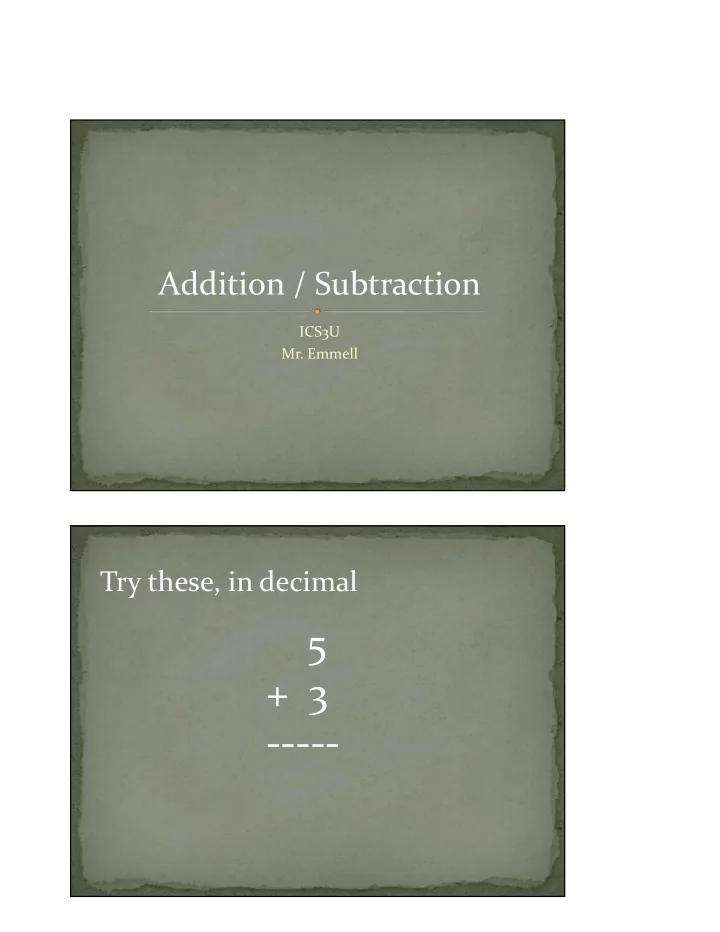

Addition / Subtraction ICS3U Mr. Emmell Try these, in decimal 5 + 3 -----
Try these, in decimal 5 + 3 ----- 8 Try these, in decimal 8 + 4 -----
Try these, in decimal 8 + 4 ----- 1 2 How did you do that? When one column overflowed…. It incremented the next column
How did you know it overflowed? When one column… tried to have a higher value than our number system allowed! Then you - Subtracted ten - Wrote the remainder - Added the carry Try these, in octal 2 8 + 4 8 -------
Try these, in octal 2 8 + 4 8 ------- 6 8 Try these, in octal 5 8 + 5 8 -------
Try these, in octal 5 + 5 = 10!!!! That’s too 5 8 much This is base 8 + 5 8 so… ------- 10 – 8 = 2 Try these, in octal 5 8 + 5 8 ------- 1 2 8
Try these, in octal 1 5 8 + 5 8 ------- Try these, in octal 1 5 8 + 5 8 ------- 2 2 8
Try these, in octal 3 5 8 + 4 6 8 ------- Try these, in octal 3 5 8 + 4 6 8 ------- 1 0 3 8
Hexadecimal works the same way! 3 16 + 6 16 ------- Hexadecimal works the same way! 3 16 + 6 16 ------- 9 16
Hexadecimal works the same way! 7 16 + 6 16 ------- Hexadecimal works the same way! 7 16 + 6 16 ------- D 16
Hexadecimal works the same way! B 9 16 + A 16 ---------- Hexadecimal works the same way! B 9 16 Remember! In decimal, + A 16 this is: 9 ------- + 10 = 19
Hexadecimal works the same way! B 9 16 + A 16 ---------- C 3 16 Hexadecimal works the same way! 2 6 16 + 7 E 16 -------
Hexadecimal works the same way! 2 6 16 + 7 E 16 ------- A 4 16 Don’t forget binary too 1 0 0 1 2 + 1 0 1 1 2 ------------
Don’t forget binary too 1 0 0 1 2 + 1 0 1 1 2 ------------ 1 0 1 0 0 2 Now… how about subtraction? Good news! We can’t… Not really. We need to learn about complements first
So instead, we add the complement. Consider a 12 hour clock. If it is 11:00 now, then three hours later it will be 2:00 11 + 3 = 14 ≡ 2 (mod 12) 2 o’clock So instead, we add the complement. Similarly, if it is 1:00, then 4 hours ago it was 9 since 1 − 4 = −3 ≡ 9 (mod 12) 9 o’clock
So instead, we add the complement. Notice that subtracting 4 hours on the clock is the same as adding 8 hours (12 – 4). In particular, we could have computed it as follows: 1 − 4 ≡ 1 + 8 = 9 (mod 12) Binary numbers work the same way Use an 8-bit number as an example Those numbers range from 0-255 If we have 255 and add one, then we get zero because it ‘cycles back’.
So….? How do we find the complement for a number in binary? We know that 200 – 50 is the same as 200 + (255-50) (Because we roll over after 255!) HOW TO FIND “TWO’s COMPLEMENT” ⚫ Define how many bits you are using! 8-bit? ⚫ Always need to have leading zeroes. ⚫ Invert all the bits ⚫ Add one ⚫ BOOM – Two’s complement. Add normally using binary addition.
Example 100 – 58 = 42 Now for this operation, we are really saying: 100 + (-58) = 42 Let’s convert to binary Example 100 2 100 = 01100100 2 50 0 2 25 0 2 Remember! 8-bits 12 1 2 6 0 2 3 0 2 What about -58? 1 1 2 0 1
Example – Start with 58 58 2 58 = 00111010 2 29 0 2 14 1 2 Remember! 8-bits 7 0 2 3 1 2 1 1 2 What about -58? 0 1 Example 00111010 2 //58 11000101 2 //FLIP +1 //Add one 11000110 -58 = 11000110 2
Now we do the ‘addition’ 0 1 1 0 0 1 0 0 2 1 1 0 0 0 1 1 0 2 Now we do the ‘addition’ 0 1 1 0 0 1 0 0 2 1 1 0 0 0 1 1 0 2 1 0 0 1 0 1 0 1 0 2 If there is a leading one, we drop it (remember! 8-bits) Answer = 00101010 2 (42 !)
Note: Rather than having our numbers go from 0 to 255 around a clock, we have them go from −128 to 127
Recommend
More recommend